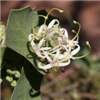Synonymy
Hakea prostrata R.Br., Trans. Linn. Soc. London 10: 184 (1810)
T: Bald Head, near King George Sound, [Western Australia], Dec. 1801, R.Brown 24; syn: AD, BM, K p.p.
Hakea glabella R.Br., Suppl. Prodr. Fl. Nov. Holl. 28 (1830). T: Swan R., [Western Australia], 1827, C.Fraser 15; syn: A, BM, E, ?K.
Hakea glabella var. paucidentata Meisn., in J.G.C.Lehmann, Pl. Preiss. 1: 564 (1845), p.p. (as to Preiss 539, 541, 544 & 545, Drummond 1), nom. illeg. (includes H. glabella in synonymy).
Hakea glabella subsp. prostrata (R.Br.) Ewart & Jean White, Proc. Roy. Soc. Victoria 22: 320 (1910), nom. inval.
[Hakea glabella ß denticulata auct. non (R.Br.) Meisn.: C.D.F.Meisner, in J.G.C.Lehmann, Pl. Preiss. 1: 564 (1845), p.p. (as to Preiss 538 & 542, Drummond 612 & coll. 1, but excluding H. denticulata R.Br.)]
Description
Erect prostrate or sprawling shrub or small tree, 0.3–4 m tall, 1.5–2 m wide, lignotuberous. Branchlets glabrous or villous. Leaves elliptic to broadly obovate throughout, 1.5–5.5 cm long, 10–35 mm wide, cordate or auriculate (auricles toothed or entire), dentate whole length or in upper half only, with 1–13 1–5 mm long teeth per side, woolly-tomentose or glabrous when young; mucro 1.5–3 mm long.
Inflorescence in upper axils, with 10–16 flowers; involucre 2–3 mm long; rachis 4.5–9.5 mm long, villous or glabrous; pedicels 6–10.5 mm long. Perianth 3.5–5.5 mm long, cream-white, pink or red. Pistil 8.5–13 mm long.
Fruit ovate, 2.3–3.8 cm long, 1–1.6 cm wide, smooth with scattered truncate prickles, glabrous. Seed 18–20 mm long; wing partly down one or both sides of seed body.
Distribution and ecology
A common species of south-western Western Australia in an area bounded by Geraldton, Kalgoorlie and Israelite Bay. Found on white or grey sand, gravel or sandy clay in low dense heath, Eucalyptus woodland, coastal heath or Jarrah woodland. Hakea prostrata has become weedy in some areas of south-eastern S.A. following the 1983 Ash Wednesday bushfires.
To plot an up to date distribution map based on herbarium collections for this species see Australia's Virtual Herbarium. Localities outside the native range may represent cultivated or naturalised records.
Flowering time
Flowers July–Oct.
Derivation of name
From prostratus, Latin for prostrate, a reference to the habit of one of the forms of this species.
Relationships
Part of Section Hakea of Bentham (as Euhakea) and characterised by a non-conical pollen presenter, leaves without obvious venation, perianths with or without hairs and fruits with or without horns. Barker et al. (1999) recognised a number of informal morphological groups within the section.
The Prostrata group all share the characteristics of flat leaves with toothed margins, glabrous pedicel and perianth, oblique pollen presenter and non-woody, spiny, obscurely-horned, camouflaged fruits which are not retained for any length of time on the bushes.
Members of the group are H. amplexicaulis, H. auriculata, H. denticulata, H. prostrata, H. pritzelii and H. spathulata, all from SW WA.
Notes
A polymorphic species, separable into sprawling vs erect and glabrous vs pubescent forms. There is also variation in flower size and colour from white, cream-white, and pink to red as indicated in the images as well as in the colour of the nectary.
In image 5 a prominent red gland is arrowed; the beetles present in this image may be plundering the nectar source, but they have not been identified. In other populations shown the gland may be pale pink or even white - the colour of the gland does not seem to be a bar to attracting insects since the specimen with a white gland also has insects visiting. Colour of the internal tepals in open flower is usually white, even if the buds may be pink as shown in one of the images here.
Hakea sp. Eastern coastal plain (G.J.Keighery 8014) recognised in FloraBase of the WA Herbarium (accessed 4 Nov. 2009) forms part of the present variation of this species, but may prove to be worthy of distinction as a separate taxon with further study. Flowers have white pedicels, pinkish outside coloration to the tepals in bud, and open with a distinctly pink internal coloration on the tepals, this deepest pink at the base of the tepal and paler towards the apex; the gland is white or pale pink, the ovary green above a short pinkish base, while the style and pollen presenter are yellow.
The occasional spines on the fruits and the retention of green coloration serves to camouflage them amongst the foliage; there are 3 fruits present in the 6th and 7th images reproduced here.
Many thanks to Kelly Shepherd and associates of the Western Australian Herbarium for additional collections and photographs of this complex.
Representative specimens
Western Australia: c. 9 km E of turnoff to Walpole on Muir Hwy, E of N end of L. Muir, W.R.Barker 2351 (AD, NSW, PERTH); 38 km S of the Geraldton Hwy turnoff on the Eneabba road, R.J.Chinnock 3211 (AD, PERTH); Boyatup Hill, A.S.George 16160 (PERTH); 1.1 km N on Ashenden Rd from Brookton Hwy, K.Shepherd 1107 (AD, PERTH); 300 m W along carpark track from the junction of the western end of the Woods Loop and Brookton Hwy, K.Shepherd 1111 (AD,PERTH). S.A.: edge of Caroline Woods and Forest Reserve, R.Bates 40495 (AD).
Weblinks
Link to FloraBase treatment of this species for WA.
For further information and images of this species in the Esperance region of Western Australia see William Archer’s Hakea page in Esperance Wildflowers
More photographs of this species can be seen on the Australian National Botanic Gardens site.
See
www.bkaussi.de/images/AustrWildblum/Hakea%20prostrata.jpg for a close-up of the flowers and leaf. The floral gland is particularly noticeable in this image.Further illustrations
W.R.Elliot & D.L.Jones, Encycl. Austral. Pl. 5: 226 (1990);
J.Young, Hakeas of W. Australia, Botanical District of Avon 21, 88 (1997)
I. Holliday, Hakeas. A Field and Garden Guide 168-9 (2005)
J.A..Young, Hakeas of Western Australia. A Field and Identification Guide 95 (2006)













